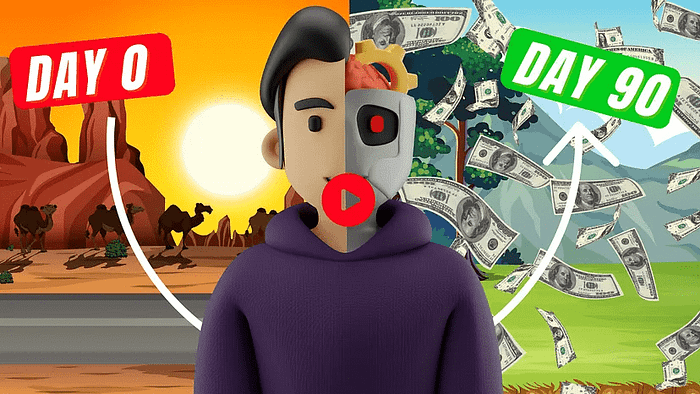How to Check If Content Is AI-Generated (Best AI Checker Tools & Methods)
AI checker tools have become essential for content creators who want to maintain authenticity in their digital presence.
As someone who regularly publishes online content, I’ve often wondered about the implications of using artificial intelligence to generate articles, blog posts, and other written material.
The question that frequently crosses my mind is whether using tools like ChatGPT or Google Bard might negatively impact my website’s search rankings or even result in de-indexing, potentially wiping out all the organic traffic I’ve worked so hard to build.
After conducting extensive research, I was relieved to discover through Google Search Central that the appropriate use of AI or automation doesn’t violate their guidelines.
This crucial distinction means content creators can leverage AI tools for content creation without fear—provided they aren’t attempting to manipulate search rankings.
Google’s primary concern remains unchanged: they want publishers to create content for human readers, not algorithms.
We strongly recommend that you check out our guide on how to take advantage of AI in today’s passive income economy.
Table of Contents
Google’s Stance on AI-Generated Content
Google’s position on AI content likely stems from their own integration of artificial intelligence into search results.
Much like Microsoft’s implementation with Bing and ChatGPT, Google is gradually incorporating AI capabilities into their real-time search functionality.
However, Googlebot still expects publishers to demonstrate they’re creating original, high-quality, people-first content.
The material you publish should showcase your earned expertise, authority, and trustworthiness—commonly referred to as E-A-T in SEO circles.
This means simply generating an article with ChatGPT and immediately publishing it isn’t sufficient for quality content standards.
For instance, if I were using an AI tool to draft an article about becoming an author, I could enhance its authenticity by incorporating my personal writing process or experiences from publishing my own works.
When leveraging AI tools, consider how you might integrate your unique perspective, case studies, or professional insights to demonstrate genuine expertise in your field.
Top AI Checker Tools: My Personal Testing Results
Having recognized the importance of balancing AI assistance with personal expertise, I decided to test various AI content detection tools.
I’ve thoroughly evaluated numerous options to help content creators identify AI-generated text before publishing it on their websites.
Let me walk you through seven of the best AI checker tools I’ve personally tested, explaining their functionality and effectiveness.
Imagine this scenario: I manage a food and beverage website with an article about premium coffee pods that’s beginning to rank well in search results.
To improve this performing content, I want to add an FAQ section—a task that would traditionally require significant time investment but seems ideally suited for AI assistance.
For this test, I used ChatGPT to generate answers to common questions about coffee pods, considering whether this content could supplement my existing article.
Additionally, I utilized a more sophisticated AI writing assistant called Koala (which I’ve extensively evaluated) to produce a comprehensive 1,600-word article about Stephen King’s net worth to determine if it would be publication-ready or require further editing.
1. GPT-Zero: Basic But Informative Analysis
GPT-Zero offers a free AI detection service with a premium subscription option ($20 monthly) for analyzing texts exceeding 5,000 characters.
The interface is straightforward—you simply paste your text into the dialog box and select which AI tool generated the content in question.
For my testing purposes, I asked ChatGPT “Can you freeze coffee pods?” and entered its response into GPT-Zero and the other six detection tools.
According to GPT-Zero’s analysis, my sample text showed a “moderate likelihood” of being AI-generated.
GPT-Zero evaluates content based on two key metrics: perplexity and burstiness.
Perplexity measures textual randomness—human writers typically incorporate unexpected word choices and phrasings, while AI-generated text follows more predictable linguistic patterns based on algorithms and machine learning.
Burstiness examines sentence length variation, another characteristic where human writers typically show more diversity than their artificial counterparts.
2. Originality.AI: Premium Detection with High Accuracy
Originality.AI stands out as one of my preferred AI detection tools, though it requires a premium subscription.
The scanning process is impressively efficient—after pasting my coffee pods text, it completed the analysis within seconds.
The results were striking: Originality.AI identified 96% of the content as artificially generated, even highlighting specific sections it determined were written by AI.
Given that the entire text was indeed AI-created, this tool demonstrated remarkable accuracy in my testing.
The visual highlighting feature proves particularly useful for identifying which portions of a longer piece might benefit from humanization or revision.
For content managers overseeing freelancers or agencies, this tool could help ensure you’re receiving authentic human-written content rather than AI-generated material presented as original work.
3. PlagiarismCheck.org: Free Detection with Nuanced Results
PlagiarismCheck.org has expanded beyond its original plagiarism detection functionality to include AI content identification.
As someone who has extensively used their plagiarism checker (covered in another article), I was curious about their AI detection capabilities.
Their AI detection tool is completely free and requires no account setup—simply visit PlagiarismCheck.org and locate their AI Plagiarism Checker.
When I entered my ChatGPT-generated coffee pods response, it identified 32% of the text as “likely” written by artificial intelligence and an additional 7.75% as “highly likely” AI-generated.
While less accurate than some premium options, I appreciate this tool’s accessibility and granular probability assessment rather than binary classification.
The distinction between “likely” and “highly likely” provides nuance that content creators can use to focus revision efforts on the most problematic sections.
4. Sapling: Developed by Prestigious Research Institutions
Sapling’s AI content detector was developed by researchers from Berkeley, Stanford, and Google—an impressive pedigree that gave me high expectations.
The tool lives on the Sapling.ai website under their content/AI detector section and offers instantaneous scanning capabilities free of charge.
When analyzing my coffee pods text, Sapling impressively flagged 100% of the content as AI-written, demonstrating perfect accuracy in this particular test case.
The tool also offers a convenient feature to copy and share results, valuable for content managers who might need to provide feedback to writers about suspected AI usage.
One interesting observation: Sapling labeled the content as “100% fake,” which I found somewhat problematic terminology.
While the text was indeed AI-generated, the information about freezing coffee pods was factually correct—highlighting an important distinction between AI authorship and factual accuracy.
5. Writer AI Content Detector: Promising But Inconsistent
The team at Writer, known for their grammar checker that competes with Grammarly, has recently shifted focus toward enterprise AI solutions.
Their AI detection tool remains available for free testing at writer.com, and I found it processed my sample text almost instantly.
Unfortunately, the results proved disappointing—Writer’s detector incorrectly classified my ChatGPT-generated text as “100% human-generated.”
This complete misidentification stood out as the least accurate assessment among all tools tested.
Such inconsistency raises questions about reliability, especially for content professionals making important decisions based on these evaluations.
Given Writer’s overall reputation in the writing tools space, this performance gap was particularly surprising and suggests their detection algorithms may require further refinement.
6. Copyleaks: Balanced Detection with Probability Scoring
Copyleaks offers another popular AI content detection solution that has received positive reviews from online evaluators.
The service is free to try—users simply create an account and paste sample text for analysis.
After entering my coffee pods text and clicking “check,” Copyleaks provided a probability score indicating a 71% likelihood that my FAQ was generated using artificial intelligence.
This balanced assessment—neither claiming absolute certainty nor missing the AI signatures entirely—seemed reasonably accurate given the content’s origin.
I particularly appreciated Copyleaks’ straightforward interface and quick processing time, making it suitable for regular content verification workflows.
The probability-based approach acknowledges the inherent uncertainty in AI detection while still providing actionable insights for content creators.
7. Extended Testing with Longer Content
To challenge these tools further, I analyzed the longer, 1,600-word article about Stephen King’s net worth generated entirely by Koala.
When I submitted this article to GPT-Zero, it identified only certain sections as AI-written and highlighted areas that might benefit from editing.
Interestingly, this partial detection occurred despite the entire article being AI-generated, suggesting that more sophisticated AI writing tools like Koala might evade complete detection.
Originality.AI performed significantly better, correctly flagging 100% of the content as artificially generated and highlighting sections for potential revision.
Sapling identified the content as “99.8% fake”—again raising that problematic terminology issue, as the biographical information about Stephen King was factually accurate despite being AI-authored.
Copyleaks also correctly identified the content as AI-written, though its metrics provided fewer actionable insights compared to other tools I tested.
The Limitations of AI Detection Technology
While these AI checker tools provide valuable insights, I discovered a significant limitation during my testing process.
Out of curiosity, I decided to input an extract from the United States Constitution into Originality.AI, my preferred detection tool.
Surprisingly—or perhaps unsurprisingly, given the technology’s current state—it classified 33% of this historical document as AI-generated.
Unless there was some form of time-traveling AI involved in 1787, this result clearly demonstrates the imperfect nature of current detection technology.
This finding underscores the importance of approaching these tools’ scores with healthy skepticism and using them as guidelines rather than definitive verdicts.
As with many emerging technologies, AI detection tools represent works in progress that will likely improve substantially over time as their algorithms become more sophisticated.
For now, content creators should view these tools as helpful assistants rather than infallible judges of content authenticity.
Best Practices for Using AI in Content Creation
If you plan to incorporate tools like ChatGPT, Google Bard, or Koala into your content creation workflow, consider these strategic approaches.
First, actively look for opportunities to infuse personal impressions, anecdotes, or professional insights into AI-generated drafts.
Always fact-check any information provided by AI tools, as they can occasionally present inaccurate or outdated information with complete confidence.
These practices will help you demonstrate the expertise, authority, and trustworthiness that Google and other search engines prioritize when evaluating content quality.
If you utilize an AI content detection tool and receive concerning results, investigate further before becoming alarmed—these tools are still evolving, and false positives do occur.
Remember that even historical texts sometimes register as partially AI-generated, demonstrating the current limitations of this technology.
With reasonable expectations and thoughtful implementation, AI detection tools can serve as valuable components in a comprehensive content quality assurance strategy.
My Personal AI Content Workflow
Based on extensive testing and practical experience, I’ve developed a content workflow that effectively balances AI assistance with human expertise and creativity.
Initially, I leverage tools like ChatGPT or Google Bard to explore potential topics, identify relevant terms, and understand what my target audience is searching for online.
This preliminary research phase ensures I’m creating content that addresses actual user needs—after all, what’s the point of writing about coffee pods or celebrity net worth if readers aren’t actively seeking this information?
Once I’ve established my content direction, I might use AI to help draft certain sections, but I always incorporate personal insights, experiences, and perspective to enhance authenticity.
After completing a draft that satisfies my quality standards and passes a thorough grammar check, I’ll paste the content into one of the AI detection tools profiled in this article.
Currently, I prefer Originality.AI for this purpose, though I acknowledge its imperfect accuracy—a limitation shared by all detection tools in this emerging technological category.
Conclusion
AI checker tools provide content creators with valuable insights into the nature and origin of digital text.
As artificial intelligence continues reshaping content creation processes, these detection technologies will play increasingly important roles in maintaining authenticity and transparency.
While current AI detectors demonstrate impressive capabilities, they also show notable limitations—sometimes misclassifying historical documents as machine-generated or failing to identify sophisticated AI writing.
The key takeaway for content creators is balance: leverage AI tools for efficiency and inspiration while incorporating genuine human expertise, experience, and perspective.
Google and other search engines don’t prohibit AI-assisted content creation but expect publishers to demonstrate authentic knowledge and prioritize human readers’ needs.
By thoughtfully integrating AI assistance into a content strategy that emphasizes expertise and reader value, publishers can maintain search visibility while benefiting from technological advancements.
As AI detection technology improves over time, we can expect more accurate and nuanced evaluations of content authenticity, further supporting high-quality digital publishing practices.
For now, approach these tools as helpful guides rather than definitive authorities, and focus on creating genuinely valuable content regardless of which technological tools assist in its development.

We strongly recommend that you check out our guide on how to take advantage of AI in today’s passive income economy.




